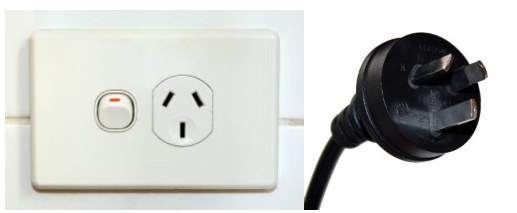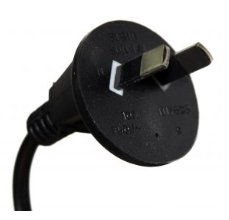Power plug & outlet Type I
Date:2022-08-02 Click:2123 Source:Caron
TYPE I

Type I is mainly used in Australia, New Zealand, Papua New Guinea, China and Argentina.
This 10 amp plug has two flat 1.6 mm thick blades, set at 30° to the vertical, forming an upside-down V. Their centres are spaced 13.7 mm apart and both prongs measure 17.3 mm in length and 6.3 mm in width. The flat earth blade also measures 6.3 by 1.6 mm, but it is 20 mm long. The distance between the centre of the grounding pin and the middle of the plug is 10.3 mm. There is an ungrounded version of this plug as well, with only two flat V-shaped prongs. Both plug versions have insulated live and neutral pins, so even if the plug is not fully inserted into a socket, touching the exposed part of the prongs can’t give you a shock.

A plug/socket configuration rated at 15 amps is also available, but the ground pin is wider: 8 mm instead of 6.3 mm. A standard 10 amp plug will fit into a 15 amp outlet, but a 15 amp plug only fits this special 15 amp socket. There is also a 20 amp plug whose prongs are wider still. A lower-amperage plug will always fit into a higher-amperage outlet but not vice versa. Australia’s plug/socket system is codified as standard AS 3112. Although there are slight differences (the pins of Chinese plugs are 1 mm longer and the sockets are installed with the earth contact facing upwards), the Australian plug mates with the socket used in the People’s Republic of China (mainland China).
The reason as to why the dimensions of the Australian type I are very similar to those of type A is because the Australasian standard is actually an obsolete type of American plug. It was patented in 1916 by Harvey Hubbell II, the same electrical engineer who had invented the type A plug. Hubbell’s three-blade design never proved popular in the U.S. because of its incompatibility with the existing type A plug, but it was favoured in Australia over the British type D system, because it was easier for local manufacturers to make plugs with flat pins rather than round ones. In the 1930s, the predominant Australian electrical accessory manufacturers, along with the State Electricity Commission of Victoria, decided to standardize on Hubbell’s design.

